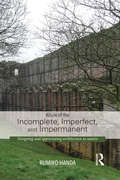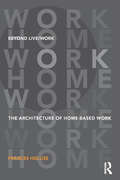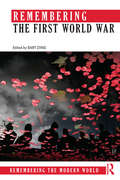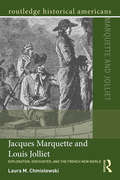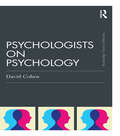- Table View
- List View
Allure of the Incomplete, Imperfect, and Impermanent: Designing and Appreciating Architecture as Nature
by Rumiko HandaArchitects have long operated based on the assumption that a building is 'complete' once construction has finished. Striving to create a perfect building, they wish for it to stay in its original state indefinitely, viewing any subsequent alterations as unintended effects or the results of degeneration. The ideal is for a piece of architecture to remain permanently perfect and complete. This contrasts sharply with reality where changes take place as people move in, requirements change, events happen, and building materials are subject to wear and tear. Rumiko Handa argues it is time to correct this imbalance. Using examples ranging from the Roman Coliseum to Japanese tea rooms, she draws attention to an area that is usually ignored: the allure of incomplete, imperfect and impermanent architecture. By focusing on what happens to buildings after they are ‘complete’, she shows that the ‘afterlife’ is in fact the very ‘life’ of a building. However, the book goes beyond theoretical debate. Addressing professionals as well as architecture students and educators, it persuades architects of the necessity to anticipate possible future changes and to incorporate these into their original designs.
Smell and the Ancient Senses (The Senses in Antiquity)
by Mark BradleyFrom flowers and perfumes to urban sanitation and personal hygiene, smell—a sense that is simultaneously sublime and animalistic—has played a pivotal role in western culture and thought. Greek and Roman writers and thinkers lost no opportunity to connect the smells that bombarded their senses to the social, political and cultural status of the individuals and environments that they encountered: godly incense and burning sacrifices, seductive scents, aromatic cuisines, stinking bodies, pungent farmyards and festering back-streets. The cultural study of smell has largely focused on pollution, transgression and propriety, but the olfactory sense came into play in a wide range of domains and activities: ancient medicine and philosophy, religion, botany and natural history, erotic literature, urban planning, dining, satire and comedy—where odours, aromas, scents and stenches were rich and versatile components of the ancient sensorium. The first comprehensive introduction to the role of smell in the history, literature and society of classical antiquity, Smell and the Ancient Senses explores and probes the ways that the olfactory sense can contribute to our perceptions of ancient life, behaviour, identity and morality.
Smell and the Ancient Senses (The Senses in Antiquity)
by Mark BradleyFrom flowers and perfumes to urban sanitation and personal hygiene, smell—a sense that is simultaneously sublime and animalistic—has played a pivotal role in western culture and thought. Greek and Roman writers and thinkers lost no opportunity to connect the smells that bombarded their senses to the social, political and cultural status of the individuals and environments that they encountered: godly incense and burning sacrifices, seductive scents, aromatic cuisines, stinking bodies, pungent farmyards and festering back-streets. The cultural study of smell has largely focused on pollution, transgression and propriety, but the olfactory sense came into play in a wide range of domains and activities: ancient medicine and philosophy, religion, botany and natural history, erotic literature, urban planning, dining, satire and comedy—where odours, aromas, scents and stenches were rich and versatile components of the ancient sensorium. The first comprehensive introduction to the role of smell in the history, literature and society of classical antiquity, Smell and the Ancient Senses explores and probes the ways that the olfactory sense can contribute to our perceptions of ancient life, behaviour, identity and morality.
What Psychiatry Left Out of the DSM-5: Historical Mental Disorders Today
by Edward ShorterChoice Recommended Read What Psychiatry Left Out of the DSM-5: Historical Mental Disorders Today covers the diagnoses that the Diagnostic and Statistical Manual of Mental Disorders (DSM) failed to include, along with diagnoses that should not have been included, but were. Psychiatry as a field is over two centuries old and over that time has gathered great wisdom about mental illnesses. Today, much of that knowledge has been ignored and we have diagnoses such as "schizophrenia" and "bipolar disorder" that do not correspond to the diseases found in nature; we have also left out disease labels that on a historical basis may be real. Edward Shorter proposes a history-driven alternative to the DSM.
Beyond Live/Work: The Architecture of Home-based Work
by Frances HollissBeyond Live/Work: the architecture of home-based work explores the old but neglected building type that combines dwelling and workplace, the ‘workhome’. It traces a previously untold architectural history illustrated by images of largely forgotten buildings. Despite having existed for hundreds, if not thousands, of years in every country across the globe this dual-use building type has long gone unnoticed. This book analyses the lives and premises of 90 contemporary UK and US home-based workers from across the social spectrum and in diverse occupations. It generates a series of typologies and design considerations for the workhome that will be useful for design professionals, students, policy-makers and home-based workers themselves. In the context of a globalising economy, more women in work than ever before and enabling new technologies, the home-based workforce is growing rapidly. Demonstrating how this can be a socially, economically and environmentally sustainable working practice, this book presents the workhome as the house of the future.
Remembering the First World War (Remembering the Modern World)
by Bart ZiinoRemembering the First World War brings together a group of international scholars to understand how and why the past quarter of a century has witnessed such an extraordinary increase in global popular and academic interest in the First World War, both as an event and in the ways it is remembered. The book discusses this phenomenon across three key areas. The first section looks at family history, genealogy and the First World War, seeking to understand the power of family history in shaping and reshaping remembrance of the War at the smallest levels, as well as popular media and the continuing role of the state and its agencies. The second part discusses practices of remembering and the more public forms of representation and negotiation through film, literature, museums, monuments and heritage sites, focusing on agency in representing and remembering war. The third section covers the return of the War and the increasing determination among individuals to acknowledge and participate in public rituals of remembrance with their own contemporary politics. What, for instance, does it mean to wear a poppy on armistice/remembrance day? How do symbols like this operate today? These chapters will investigate these aspects through a series of case studies. Placing remembrance of the First World War in its longer historical and broader transnational context and including illustrations and an afterword by Professor David Reynolds, this is the ideal book for all those interested in the history of the Great War and its aftermath.
Remembering the First World War (Remembering the Modern World)
by Bart ZiinoRemembering the First World War brings together a group of international scholars to understand how and why the past quarter of a century has witnessed such an extraordinary increase in global popular and academic interest in the First World War, both as an event and in the ways it is remembered. The book discusses this phenomenon across three key areas. The first section looks at family history, genealogy and the First World War, seeking to understand the power of family history in shaping and reshaping remembrance of the War at the smallest levels, as well as popular media and the continuing role of the state and its agencies. The second part discusses practices of remembering and the more public forms of representation and negotiation through film, literature, museums, monuments and heritage sites, focusing on agency in representing and remembering war. The third section covers the return of the War and the increasing determination among individuals to acknowledge and participate in public rituals of remembrance with their own contemporary politics. What, for instance, does it mean to wear a poppy on armistice/remembrance day? How do symbols like this operate today? These chapters will investigate these aspects through a series of case studies. Placing remembrance of the First World War in its longer historical and broader transnational context and including illustrations and an afterword by Professor David Reynolds, this is the ideal book for all those interested in the history of the Great War and its aftermath.
The Political Classroom: Evidence and Ethics in Democratic Education (Critical Social Thought)
by Diana E. Hess Paula McAvoyWINNER 2016 Grawemeyer Award in Education Helping students develop their ability to deliberate political questions is an essential component of democratic education, but introducing political issues into the classroom is pedagogically challenging and raises ethical dilemmas for teachers. Diana E. Hess and Paula McAvoy argue that teachers will make better professional judgments about these issues if they aim toward creating "political classrooms," which engage students in deliberations about questions that ask, "How should we live together?" Based on the findings from a large, mixed-method study about discussions of political issues within high school classrooms, The Political Classroom presents in-depth and engaging cases of teacher practice. Paying particular attention to how political polarization and social inequality affect classroom dynamics, Hess and McAvoy promote a coherent plan for providing students with a nonpartisan political education and for improving the quality of classroom deliberations.
The Political Classroom: Evidence and Ethics in Democratic Education (Critical Social Thought)
by Diana E. Hess Paula McAvoyWINNER 2016 Grawemeyer Award in Education Helping students develop their ability to deliberate political questions is an essential component of democratic education, but introducing political issues into the classroom is pedagogically challenging and raises ethical dilemmas for teachers. Diana E. Hess and Paula McAvoy argue that teachers will make better professional judgments about these issues if they aim toward creating "political classrooms," which engage students in deliberations about questions that ask, "How should we live together?" Based on the findings from a large, mixed-method study about discussions of political issues within high school classrooms, The Political Classroom presents in-depth and engaging cases of teacher practice. Paying particular attention to how political polarization and social inequality affect classroom dynamics, Hess and McAvoy promote a coherent plan for providing students with a nonpartisan political education and for improving the quality of classroom deliberations.
Healthcare in Private and Public from the Early Modern Period to 2000: From The Early Modern Period To 2000
by Paul WeindlingA key volume on a central aspect of the history of medicine and its social relations, The History of Healthcare in Public and Private examines how the modernisation of healthcare resulted in a wide variety of changing social arrangements in both public and private spheres. This book considers a comprehensive range of topics ranging from children's health, mental disorders and the influence of pharmaceutical companies to the systems of twentieth century healthcare in Britain, Eastern Europe and South Africa. Covering a broad chronological, thematic and global scope, chapters discuss key themes such as how changing economies have influenced configurations of healthcare, how access has varied according to lifecycle, ethnicity and wealth, and how definitions of public and private have shifted over time. Containing illustrations and a general introduction that outlines the key themes discussed in the volume, The History of Healthcare in Public and Private is essential reading for any student interested in the history of medicine.
Healthcare in Private and Public from the Early Modern Period to 2000
by Paul WeindlingA key volume on a central aspect of the history of medicine and its social relations, The History of Healthcare in Public and Private examines how the modernisation of healthcare resulted in a wide variety of changing social arrangements in both public and private spheres. This book considers a comprehensive range of topics ranging from children's health, mental disorders and the influence of pharmaceutical companies to the systems of twentieth century healthcare in Britain, Eastern Europe and South Africa. Covering a broad chronological, thematic and global scope, chapters discuss key themes such as how changing economies have influenced configurations of healthcare, how access has varied according to lifecycle, ethnicity and wealth, and how definitions of public and private have shifted over time. Containing illustrations and a general introduction that outlines the key themes discussed in the volume, The History of Healthcare in Public and Private is essential reading for any student interested in the history of medicine.
Photography and Its Origins
by Tanya Sheehan Andres ZervigonRecent decades have seen a flourishing interest in and speculation about the origins of photography. Spurred by rediscoveries of ‘first’ photographs and proclamations of photography’s death in the digital age, scholars have been rethinking who and what invented the medium. Photography and Its Origins reflects on this interest in photography’s beginnings by reframing it in critical and specifically historiographical terms. How and why do we write about the origins of the medium? Whom or what do we rely on to construct those narratives? What’s at stake in choosing to tell stories of photography’s genesis in one way or another? And what kind of work can those stories do? Edited by Tanya Sheehan and Andrés Mario Zervigón, this collection of 16 original essays, illustrated with 32 colour images, showcases prominent and emerging voices in the field of photography studies. Their research cuts across disciplines and methodologies, shedding new light on old questions about histories and their writing. Photography and Its Origins will serve as a valuable resource for students and scholars in art history, visual and media studies, and the history of science and technology.
Photography and Its Origins
by Tanya Sheehan Andres ZervigonRecent decades have seen a flourishing interest in and speculation about the origins of photography. Spurred by rediscoveries of ‘first’ photographs and proclamations of photography’s death in the digital age, scholars have been rethinking who and what invented the medium. Photography and Its Origins reflects on this interest in photography’s beginnings by reframing it in critical and specifically historiographical terms. How and why do we write about the origins of the medium? Whom or what do we rely on to construct those narratives? What’s at stake in choosing to tell stories of photography’s genesis in one way or another? And what kind of work can those stories do? Edited by Tanya Sheehan and Andrés Mario Zervigón, this collection of 16 original essays, illustrated with 32 colour images, showcases prominent and emerging voices in the field of photography studies. Their research cuts across disciplines and methodologies, shedding new light on old questions about histories and their writing. Photography and Its Origins will serve as a valuable resource for students and scholars in art history, visual and media studies, and the history of science and technology.
The United States and Latin America: A History with Documents
by Jeffrey Taffet Dustin WalcherThe United States and Latin America presents a complex and dynamic view ofthe relationship between the United States and Latin America. Through acombination of targeted, thematic chapters and a range of freshly-translateddocuments, Jeffrey F. Taffet and Dustin Walcher illuminate the historicalcontinuities and conflicts that have defined the vital relationship. Givingequal weight to Latin American and United States voices, this text providesan essential collection of primary sources for students and scholars, and isan indispensable touchstone for anyone interested in the histories of theUnited States and Latin America.
The Socialist Life of Modern Architecture: Bucharest, 1949-1964 (Architext)
by Juliana MaximThe Socialist Life of Modern Architecture is the first systematic architectural history of Romania under socialism written in English. It examines the mechanisms through which modern architecture was invested with political meaning and, in reverse, how specific architectural solutions came to define the socialist experience. Each of the book’s three parts traces the historical development of one key aspect of Romania’s architectural culture between the years 1949–1964: the planning and construction of housing districts in Bucharest; the role of typification of design and standardization of construction in a project of cultural transformation; the production and management of a folk architectural tradition. Going beyond buildings and architects to consider the use of photography, painting, and novels, as well as narrations of history and the formation of an ethnographic architectural heritage, the author explores how buildings came to participate in the cultural imagination of socialism—and became, in fact, a privileged medium of socialism. Part of the growing interest in the significance of Soviet Bloc architecture, this is an important contribution to the fields of architectural history, cultural history, and visual culture.
Julius Caesar and the Transformation of the Roman Republic
by Tom StevensonJulius Caesar and the Transformation of the Roman Republic provides an accessible introduction to Caesar’s life and public career. It outlines the main phases of his career with reference to prominent social and political concepts of the time. This approach helps to explain his aims, ideals, and motives as rooted in tradition, and demonstrates that Caesar’s rise to power owed much to broad historical processes of the late Republican period, a view that contrasts with the long-held idea that he sought to become Rome’s king from an early age. This is an essential undergraduate introduction to this fascinating figure, and to his role in the transformation of Rome from republic to empire.
Julius Caesar and the Transformation of the Roman Republic
by Tom StevensonJulius Caesar and the Transformation of the Roman Republic provides an accessible introduction to Caesar’s life and public career. It outlines the main phases of his career with reference to prominent social and political concepts of the time. This approach helps to explain his aims, ideals, and motives as rooted in tradition, and demonstrates that Caesar’s rise to power owed much to broad historical processes of the late Republican period, a view that contrasts with the long-held idea that he sought to become Rome’s king from an early age. This is an essential undergraduate introduction to this fascinating figure, and to his role in the transformation of Rome from republic to empire.
Jacques Marquette and Louis Jolliet: Exploration, Encounter, and the French New World (Routledge Historical Americans)
by Laura M. ChmielewskiIn this succinct dual biography, Laura Chmielewski demonstrates how the lives of two French explorers – Jacques Marquette, a Jesuit missionary, and Louis Jolliet, a fur trapper – reveal the diverse world of early America. Following the explorers' epic journey through the center of the American continent, Marquette and Jolliet combines a story of discovery and encounter with the insights derived from recent historical scholarship. The story provides perspective on the different methods and goals of colonization and the role of Native Americans as active participants in this complex and uneven process.
Sustainable Heritage: Merging Environmental Conservation and Historic Preservation
by Amalia Leifeste Barry L. StiefelThis book brings together ecological-conservation theory and heritage-preservation theory and shows how these two realms have common purpose. Through theoretical discussion and illustrative examples, Sustainable Heritage reframes the history of multiple movements within preservation and sustainable-design strategies into cross-disciplinary themes. Through topics such as Cultural Relationships with Nature, Ecology, Biodiversity, Energy, and Resource Systems; Integrating Biodiversity into the Built Environment Rehabilitation Practice; Fixing the Shortcomings Within Community Design, Planning, and Policy; Strategies for Adapting Buildings and Structures for Rising Sea Levels; and Vehicles as a Microcosm of Approaching Built Environment Rehabilitation, the book explores contemporary ecological and heritage ethics as a strategy for improving the livability of the built environment. The authors provide a holistic critique of the challenges we face in light of climate and cultural changes occurring from the local to the global level. It synthesizes the best practices offered by separate disciplines as one cohesive way forward toward sustainable design. The authors consider strategies for increasing the physical and cultural longevity of the built environment, why these two are so closely paired, and the potential their overlap offers for sustained and meaningful inhabitation. Sustainable Heritage unites students and professionals in a wide range of disciplines with one common language and more closely aligned sets of objectives for preservation and sustainable design.
Architecture's Pretexts: Spaces of Translation
by Aarati KanekarThe aim of this book is to expose readers to architecture’s pretexts that include literary narratives, film, theatre, painting, music, and ritual, as a bridge between diverse intellectual territories and architecture. It introduces a selection of seminal modern and contemporary architectural projects, their situation within the built environment, and their intellectual and formal situation/context as pretexts and design paradigms. Connections between diverse bodies of information will be cultivated along with the ability to posit consequential relationships for the production of architecture. Architecture’s Pretexts seeks to cultivate a vision for architecture that sponsors operative links between the discipline of architecture and those outside of architecture. Exploring the works of various architects including Guiseppe Terragni, Peter Eisenman, Peter Zumthor, Perry Kulper and Smout Allen, and Rem Koolhaas, this book provides the framework to understanding architecture through the lens of art. Key concepts discussed are: allegories, diagrams, form, material, montage, movement, musical ratios, narrative sequence and representation. A valuable tool, with over 75 black and white illustrations, for students and professionals interested in interdisciplinary methods of design thinking.
Architecture's Pretexts: Spaces of Translation
by Aarati KanekarThe aim of this book is to expose readers to architecture’s pretexts that include literary narratives, film, theatre, painting, music, and ritual, as a bridge between diverse intellectual territories and architecture. It introduces a selection of seminal modern and contemporary architectural projects, their situation within the built environment, and their intellectual and formal situation/context as pretexts and design paradigms. Connections between diverse bodies of information will be cultivated along with the ability to posit consequential relationships for the production of architecture. Architecture’s Pretexts seeks to cultivate a vision for architecture that sponsors operative links between the discipline of architecture and those outside of architecture. Exploring the works of various architects including Guiseppe Terragni, Peter Eisenman, Peter Zumthor, Perry Kulper and Smout Allen, and Rem Koolhaas, this book provides the framework to understanding architecture through the lens of art. Key concepts discussed are: allegories, diagrams, form, material, montage, movement, musical ratios, narrative sequence and representation. A valuable tool, with over 75 black and white illustrations, for students and professionals interested in interdisciplinary methods of design thinking.
Psychologists on Psychology (Psychology Press & Routledge Classic Editions)
by David CohenThis is a Classic Edition of David Cohen’s unique collection of interviews with eminent psychologists, first published in 1977. The book presents conversations with thirteen of the world’s great psychologists, who dominated the subject from 1950 to 1980, and who shaped psychology as we know it today. Those interviewed include Burrhus Skinner, Donald Broadbent, Hans Eysenck and also R.D Laing, Noam Chomsky, and Niko Tinbergen. This classic edition contains a newly written introduction which contextualises the interviews as a critique and diagnosis of the problems of contemporary psychology in the mid 1970’s. Together, the interviews cover a broad range of approaches, and the lively debates about theory, practice and what it means to be human which were occurring at that time. The book shows the different approaches each psychologist has to the subject and why, in terms of background, education, experimental research and personal preference, they came to the positions they hold. The classic edition of Psychologists on Psychology provides an astute, critical snapshot of psychology at that time. It will be of great interest to anyone with an interest in psychology, the history of psychology, and the history of ideas.
Psychologists on Psychology (Psychology Press & Routledge Classic Editions)
by David CohenThis is a Classic Edition of David Cohen’s unique collection of interviews with eminent psychologists, first published in 1977. The book presents conversations with thirteen of the world’s great psychologists, who dominated the subject from 1950 to 1980, and who shaped psychology as we know it today. Those interviewed include Burrhus Skinner, Donald Broadbent, Hans Eysenck and also R.D Laing, Noam Chomsky, and Niko Tinbergen. This classic edition contains a newly written introduction which contextualises the interviews as a critique and diagnosis of the problems of contemporary psychology in the mid 1970’s. Together, the interviews cover a broad range of approaches, and the lively debates about theory, practice and what it means to be human which were occurring at that time. The book shows the different approaches each psychologist has to the subject and why, in terms of background, education, experimental research and personal preference, they came to the positions they hold. The classic edition of Psychologists on Psychology provides an astute, critical snapshot of psychology at that time. It will be of great interest to anyone with an interest in psychology, the history of psychology, and the history of ideas.
Mussolini (Routledge Historical Biographies)
by Peter NevilleThis new edition of Peter Neville’s Mussolini traces and analyses the life of one of the most fascinating twentieth century European dictators, Benito Mussolini, while placing his life in its historic Italian context. Engaging and accessible, the Duce’s career is traced from his roots as a journalist and socialist to his capture and execution in 1945, addressing crucial issues throughout: was Mussolini really a far right ideologist, or simply a political opportunist? How successful was he at communicating his core beliefs to the Italian people? This thoroughly updated new edition synthesises the scholarship of the last ten years to consider Italian atrocities in Africa, and the reaction to them by ordinary Italians, in addition to a consideration of the relationship between Mussolini and Hitler while other periods of Mussolini’s life are expanded upon and reconsidered. Finally, the author considers Mussolini’s legacy and his continuing influence in modern Italy. This biography gives students a useful analytical introduction to the period and the man and provides an explanation of what fascism was and why it resonated with so many people in Italy. It will be essential reading for all students of modern Italy and the history of fascism.
Mussolini (Routledge Historical Biographies)
by Peter NevilleThis new edition of Peter Neville’s Mussolini traces and analyses the life of one of the most fascinating twentieth century European dictators, Benito Mussolini, while placing his life in its historic Italian context. Engaging and accessible, the Duce’s career is traced from his roots as a journalist and socialist to his capture and execution in 1945, addressing crucial issues throughout: was Mussolini really a far right ideologist, or simply a political opportunist? How successful was he at communicating his core beliefs to the Italian people? This thoroughly updated new edition synthesises the scholarship of the last ten years to consider Italian atrocities in Africa, and the reaction to them by ordinary Italians, in addition to a consideration of the relationship between Mussolini and Hitler while other periods of Mussolini’s life are expanded upon and reconsidered. Finally, the author considers Mussolini’s legacy and his continuing influence in modern Italy. This biography gives students a useful analytical introduction to the period and the man and provides an explanation of what fascism was and why it resonated with so many people in Italy. It will be essential reading for all students of modern Italy and the history of fascism.
